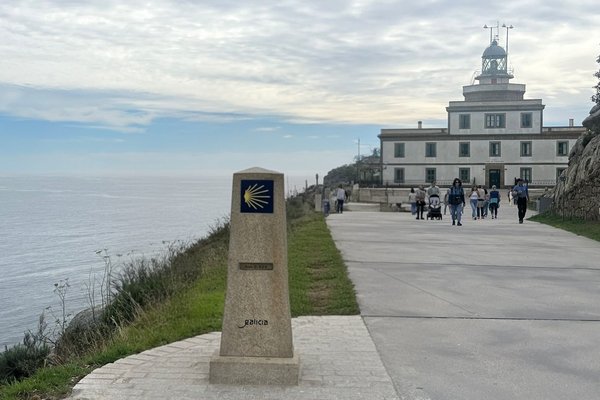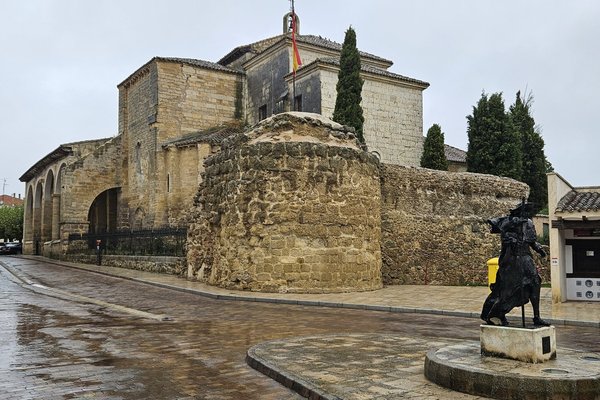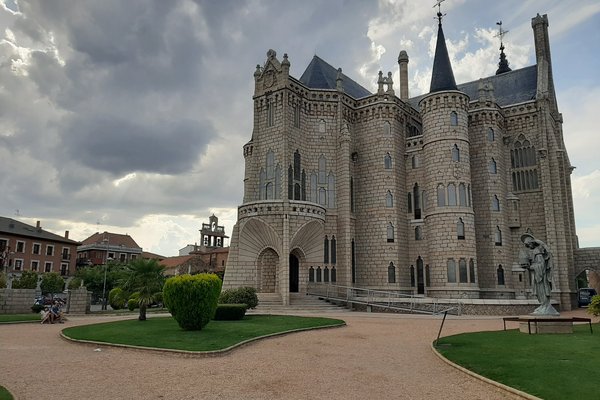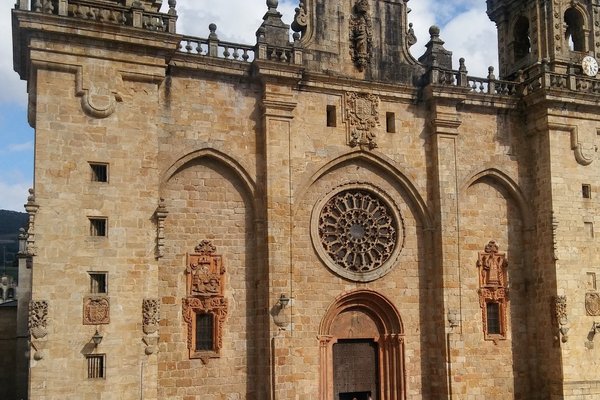Spain
Route of Santiago de Compostela
Routes of Santiago de Compostela: Camino Francés and Routes of Northern Spain comprise four historic Christian pilgrimage routes originating in the Middle Ages.
The routes drew pilgrims from the Iberian Peninsula and the rest of Europe. They start from the French-Spanish border and end at the Cathedral of Santiago de Compostela, where the remains of the apostle Saint James the Great are said to be buried. Along the route, there are over 1800 associated historic buildings, including cathedrals, churches, monasteries, hospitals, inns and public works.
Community Perspective: This is best experienced on foot of course, and Clyde has completed the full Camino. Others like Jay (six days), Ian (120km) and Frederik (7km) did parts of it.
Site Info
Official Information
- Full Name
- Routes of Santiago de Compostela: Camino Francés and Routes of Northern Spain (ID: 669)
- Country
- Spain
- Status
-
Inscribed 1993
Site history
History of Route of Santiago de Compostela
- 2015: Extended
- To include four Christian pilgrimage routes in northern Spain and 16 of the most culturally significant structures along these routes
- 2015: Name change
- From "Routes of Santiago de Compostela" to "Routes of Santiago de Compostela: Camino Francés and Routes of Northern Spain"
- 1993: Inscribed
- Inscribed
- 1993: Revision
- Includes now former TWHS Eunate - Iglesia de Sta Maria, Burgos - Monasterio de las Huelgos, Jaca - Cathedral of San Pedro Apostol, Torres Del Rio - Iglesia del Santo Seplucro, Burgos - Miraflores Charterhouse (Monastery), Najera - Sta Maria la Real (inc in Compos route), Leon - Basilica of San Isidoro, Leon - Catedral de Sta Maria (all 1995), Conjunto fortificado de Pamplona (1998)
- Type
- Cultural
- Criteria
- ii
- iv
- vi
Links
- UNESCO
- whc.unesco.org
- Official
-
- peregrinossantiago.es — Peregrinos Santiago
- Related
-
- worldheritagesite.org — Inventory of sites included along the Route
All Links
UNESCO.org
- whc.unesco.org — whc.unesco.org/
Official Website
- peregrinossantiago.es — Peregrinos Santiago
Related Resources
- worldheritagesite.org — Inventory of sites included along the Route
News Article
- June 26, 2018 dailymail.co.uk — Fury as local handicraft teacher botches restoration of 500-year-old effigy of St George in Spanish church
Community Information
- Community Category
- Religious structure: Christian
Travel Information
Exact locations inscribed twice (or more)
Recent Connections
-
Astronomical clocks
"The interior face of the clock of Asto…
-
True Cross
"The Monastery of Santo Toribio de Liéb…
-
Perfect Inscriptions
1993
Connections of Route of Santiago de Compostela
- Geography
-
-
Pyrenees
The route starts in the Pyrenees at Somport and at Roncevalles, both part of this site. -
Linear inscriptions
It is not absolutely clear whether this site is inscribed as a series of point monuments or in the form of a "line". The AB eval states "The entire route from the French Frontier to Santiago itself has been nominated" ..... "At the present time a 30 mtr strip on either side of the route is protected" -
Bay of Biscay
Chemin de la Côte -
Basque
-
- History
-
-
Knights Templar
Ponferrado - Castillo de los Templarios, a Templar castle created after 1178 when Fernando II of León donated the city to the Templar order for protecting pilgrims on the route.
-
- Architecture
-
-
Art Nouveau
Palacio episcopal in Astorga by Gaudí -
Moorish revival
Episcopal Palace in Astorga -
Gothic Revival
Episcopal Palace in Astorga -
Isabelline style
Miraflores Charterhouse in Burgos -
Baroque
Sobrado Abbey: "The monumental new Baroque abbey church was dedicated in 1708."See en.wikipedia.org
-
Mudejar style
"Sahagún contains some of the earliest examples of the mudéjar architecture. It lies on the Way of St. James and is often considered the half-way point between St. Jean Pied de Port and Santiago de Compostela." (wiki), including Church of San Lorenzo, Church of San TirsoSee es.wikipedia.org
-
Romanesque
Romanic bridge over Arga river (early 11th century) in Puente La Reina
-
- Damaged
-
-
Thefts since inscription
Codex Calixtinus manuscript stolen from Santiago de Compostela -
Destroyed or damaged by Earthquake
Lugo Cathedral: The "Renaissance retablo at the high altar (...) was destroyed in the 1755 Lisbon earthquake and fragments of it are housed in the church."See en.wikipedia.org
-
- World Heritage Process
-
-
Extended
2015: To include four Christian pilgrimage routes in northern Spain and 16 of the most culturally significant structures along these routes -
Perfect Inscriptions
1993 -
Derived from more than one TWHS
Includes now former TWHS Eunate - Iglesia de Sta Maria, Burgos - Monasterio de las Huelgos, Jaca - Cathedral of San Pedro Apostol, Torres Del Rio - Iglesia del Santo Seplucro, Burgos - Miraflores Charterhouse (Monastery), Najera - Sta Maria la Real (inc in Compos route), Leon - Basilica of San Isidoro, Leon - Catedral de Sta Maria (all 1995), Conjunto fortificado de Pamplona (1998 -
Recommended for combination by AB
"ICOMOS suggests therefore that consideration be given by the relevant States Parties to the possibility of an eventual extension of the property to other lengths of the Route outside Spain" -
Exact locations inscribed twice (or more)
Contains 3 sites already inscribed on their own account: Burgos, Santiago and Lugo -
Incorrect UNESCO 'Number of locations'
Shows 20 (those of the 2015 extension), but these include 4 main routes and 16 individual sites that represent those routes. The original main route is omitted, and there are 1912 "associated sites" as well.
-
- Religion and Belief
-
-
Fortified religious buildings
The monastery of Santa maría la real de Nájera, home to the Navarran Royal mausoleum is a classic example of a fortified church and an important stop on the Camino de Santiago in Spain. "The exterior of Santa María la Real shows characteristics of a fortified building...Defensive needs led to high walls and buttress with the function of bastions" (wiki) -
Cathedrals
St Pedro, Jaca -
Pilgrimage route
Way of St. James -
Order of Cluny
Monastery of San Juan de la Peña, Jaca (Sancho le Grand de Navarre, roi de Navarre, a introduit au monastère la règle bénédictine de Cluny en 1049); Monastery of San Facundo ruins, Convent of San Benito and San Benito Arch, Sahagún (The monastery of Sahagún in León was a central one, as it was the biggest propagator of the Cluniac observance); Monastery of San Zoilo (St. Zoilus), Carrión de los Condes. (Dès 1080, les Clunisiens de San Zoilo entament une action de réforme active dans les royaumes de Castille et Leon. Son prieur, venant directement de Cluny, en est le représentant en Espagne); Parish Church of San Martín, Frómista (En 1118, elle est placée sous la dépendance de San Zoilo de Carrión de los Condes, rejoignant ainsi la congrégation clunisienne); Monastery of San Salvador de Leire (Convirtiéndose en abanderado de la introducción de la reforma de Cluny en el Pirineo); Monastery of San Pedro de Cardena (El declive comienza en el siglo XII y durante un breve periodo de tiempo pasó a pertenecer, como priorato, a la todavía poderosa Abadía de Cluny); Monastery of Santa María la Real, Nájera (Originally a royal foundation, it was ceded by Alfonso VI to the Cluniac order) -
Cistercian
Sobrado Abbey "is a Cistercian monastery".See en.wikipedia.org
-
Marian Shrines
Lugo Cathedral is dedicated to the Virgin Mary ("Catedral de Santa María de Lugo"). The cathedral houses the Chapel of the Virgin of the Big Eyes ("Virgen de los Ojos Grandes"). She is the patron saint of the city of Lugo.See es.wikipedia.org
-
Christian Pilgrimage Sites
Several sites on the route to Santiago in France were pilgrimage sites in their own right, often linked to a saint's relics, e.g. Abbey Church of Sainte-Foy, the church of Saint-Léonard-de-Noblat, the abbey of Saint-Guilhem-le-Désert, Saint-Gilles du Gard, Notre-Dame de l'Épine, the Basilica of Saint-Étienne in Neuvy-Saint-Sépulchre, Le Puy Cathedral, Basilica of Notre-Dame du Port, Basilica of Saint Severinus in Bordeaux, Tour Saint-Jacques in Paris. (Nomination file) -
True Cross
"The Monastery of Santo Toribio de Liébana (...) holds and venerates part of the Lignum Crucis discovered in Jerusalem by Saint Helena of Constantinople, which is claimed to be the largest piece held." (Wikipedia)
-
- Human Activity
- Constructions
-
-
Tunnels
Tunnel de San AdrianSee en.wikipedia.org
-
Notable Bridges
Puente la Reina, Kingdom of Navarre tourist web site: "the Romanesque Kridge across the river Arga is the most amazing sight of all. It is one of the most beautiful and distinguished examples of Romanesque architecture on the way to Santiago and is what gives its name to this town" -
Hospitals
Includes several former hospitals for pilgrims, for example the ruins of the Hospital of Paradiella. -
Freestanding Bell Tower
Santo Domingo de la Calzada Cathedral, with its external bell tower. -
Astronomical clocks
"The interior face of the clock of Astorga Cathedral has a 24-hour dial which shows the lunar phase and the date" (location 1812 in RoSdC)
-
Walled cities
The Roman Walls of Lugo -
Obelisk
component 1197 Watertrough FountainSee maps.app.goo.gl
-
Mazes
Laberinto del Camino de Santiago -
Clock Tower
Clock towers of the cathedrals of Lugo, Oviedo and Bilbao
-
- WHS on Other Lists
-
-
Most beautiful villages
Santillana del Mar is among "los pueblos más bonitos de España" -
World Monuments Watch (past)
Concern about damage from new highway (2010) -
Ramsar Wetlands
Txingudi + Ría del Eo -
World Biosphere Reserves
Ribeira Sacra E Serras Do Oribio E Courel Biosphere Reserve, Spain (2021)
-
- Timeline
-
-
Built in the 11th century
For Santiago's Cathedral and Puente la Reina
-
- WHS Hotspots
- WHS Names
-
-
Name changes
From "Routes of Santiago de Compostela" to "Routes of Santiago de Compostela: Camino Francés and Routes of Northern Spain"
-
News
- dailymail.co.uk 06/26/2018
- Fury as local handicraft teacher b…
Recent Visitors
Visitors of Route of Santiago de Compostela
- Adam Hancock
- Adrian Turtschi
- Alberto Rodriguez Gutierrez
- aleserre
- Alexander Barabanov
- Alexander Lehmann
- alicemears
- Alikander99
- Ammon Watkins
- Ana
- Ana Lozano
- Angela Vandyck
- Anna Wludarska
- Antonio J.
- Argo
- Artur Anuszewski
- Aspasia
- Astraftis
- Atila Ege
- AustralLights
- awestix
- BaziFettehenne
- Bill Maurmann
- Bin
- Birgitte Sørensen
- bossc
- Bram de Bruin
- CampbellME
- Carlos Sotelo
- Caspar
- Catoplayer
- CeeMon
- Cezar Grozavu
- chenboada
- Cheryl
- chiuliqi
- Christian Wagner
- Christravelblog
- Clyde
- Cobaltrage
- Corinne Vail
- daneva
- Dani Cyr
- Daniela Hohmann
- Daniel Chazad
- Danieljbromberg
- Dan Pettigrew
- David Aaronson
- David Berlanda
- del
- Digits
- Dimitar Krastev
- Dolemite92
- Don Irwin
- Dorejd
- Echwel
- edstar500
- Elaine McArdle
- Els Slots
- Emilia
- Erik Jelinek
- Eva Kisgyorgy
- Evgenii
- fabi-ddorf
- Fan Yibo
- Farinelli
- Feldhase
- Femke Roos
- Filip Murlak
- Frederik Dawson
- FS
- Garry Jackson
- George Gdanski
- GeorgeIng61
- Gernot
- HaraldOest
- Harry Mitsidis
- Hasco
- headventure
- Iain Jackson
- Ian Cade
- Ingemar Eriksson
- irosey
- Ivan Rucek
- Jakob F.
- janem
- Janina Lehmann
- janis
- Janos
- Jan-Willem
- Jarek Pokrzywnicki
- Jarrod_Byham
- Jasam
- Javier
- Javier Coro
- Jay T
- Jean Lecaillon
- Jens
- Jezza
- João Aender
- Jonas Hagung
- Jonas Kremer
- jonathanfr
- JoStof
- Joyce van Soest
- JR's HERITAGE SITES
- Jurre
- jxrocky
- Karito Vies
- Kbecq
- Kedp2023
- Ken DJ
- Kevin247
- kjluebke
- Klaus Freisinger
- KngAlaric
- Knut
- krtek
- Krzysztof B
- Kurt Lauer
- Kyle Magnuson
- La Concy
- Lado Joel
- Lara Adler
- LaVale
- leroykstlj
- lichia
- Lisu Marian
- Little Lauren Travels
- Loic Pedras
- Luboang
- Lucas Del Puppo
- Lucio
- Ludvan
- Luis Filipe Gaspar
- Luj3904
- Maciej Gil
- Malgorzata Kopczynska
- Martin
- Martina Rúčková
- Marty
- Mathijs
- MAURO PODDA PANI
- Max
- MaYumin
- MH
- Mia esguerra
- michaelsballard
- Miguel Marquez
- Mikan22
- Mikko
- Ming_9734
- MMM
- Morodhi
- Msarmiento1979
- nan
- napalm
- Niall Sclater
- Nick Kuzmyak
- Nihal Ege
- PabloNorte
- Palimpsesto
- Paola Laura
- Patrik
- Patrik_globe
- Paul Schofield
- Peltzi
- Persian Globetrotter
- Petteri
- pghgeekgrrl
- Philipp Leu
- Philipp Peterer
- Pieter Dijkshoorn
- Piotr Wasil
- Porcho
- pressdm
- puessergio
- Randi Thomsen
- Remigiusz
- Reza
- Roel Sterken
- Roger Ourset
- Roman Bruehwiler
- Samy G
- Sandmann15
- Sclowitz
- scubarrie
- SDMArado
- Shannon O'Donnell
- Shijie ZHU
- sibariam
- Simonf
- Solivagant
- Ssong.x
- Stan
- Stanislaw Warwas
- stephanvermeulen
- Svein Elias
- Szucs Tamas
- Tamara Ratz
- Tammy Gouldstone
- Taotao Chen
- Tarquinio_Superbo
- Tcchang0825
- Tevity
- Thomas Buechler
- Thomas Harold Watson
- Thomas van der Walt
- Tim Allen
- tingmelvin
- Tom Flaten
- Tonisan
- Traveling Girl
- triath
- Truls Brekke
- Tsunami
- usagi1974
- Vanessa Buechler
- Van Hung
- Vernon Prieto
- Viaje al Patrimonio
- voyager
- Walter
- Wieland
- Wimmy
- Wojciech Fedoruk
- Xander Huang
- Xiong Wei
- Xiquinho Silva
- Yongcheng Liu
- Zoë Sheng
- Zos M
- Александар Стојиљковић
Community Reviews
Show full reviews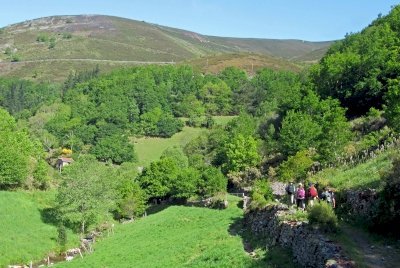
One of my more indelible travel memories is of watching a truckload of pilgrims departing for the Hajj, joyfully singing and cheering as they left Luxor, Egypt, in October 2012. I thought about those pilgrims embarking on a pilgrimage as I hiked along some of the Routes of Santiago de Compostela in Spain last month, and wondered whether the pilgrims starting off on the Camino felt similar joy as they started their journeys. The routes were great places for reflection and for enjoying the varied nature of the north of Spain. Although I traveled with a tour group, there was ample time to appreciate the trails in relative solitude, and even as we neared Santiago and more pilgrims appeared on the trails, it was still not terribly crowded in late May. In total, we spent six days hiking the routes: two days admiring the rugged coastal beauty of the Camino del Norte; two days crossing the hills of the original Camino Primitivo, which Asturian King Alfonso II established from Oviedo in the 9th century; and two days along the more traveled Camino Francés, which was the first section of the Camino in Spain inscribed on the World Heritage Site list. The weather was remarkably sunny and warm for the entire trip, and I thoroughly enjoyed the tranquility of the trails. While I didn't get to witness any of the pilgrims as they first embarked on the Camino, I can say with certainty that those I saw at Monte do Gozo, …
Keep reading 0 comments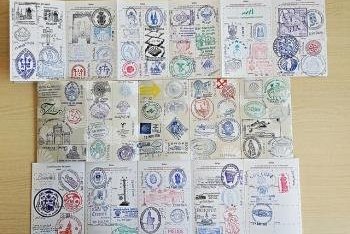
I visited this WHS in April-May 2016. I walked the Camino Frances from St Jean in France to Santiago de Compostela in 32 full walking days (775km). Walking from France, I missed the Somport pass which would take slightly more time. A lot of planning and mental training/endurance was required to complete this pilgrimage/WHS but I managed to fulfill my vow. First of all, I had to sacrifice a year's worth of leave to have enough time for the longest Camino. Secondly, I opted to walk in Spring which is by far less crowded/cooler but at the same time I had to bring a windbreaker jacket with me. In hindsight, this was a crucial decision as most probably I would not have completed the Camino Frances had I opted for summer (not only because of the heat especially across the meseta, but mostly because of the huge surge of pilgrims). Already towards the beginning of May, I walked by a couple of villages with no room/bed available in any albergue by 14:30 (the film The Way has drastically increased the number of North Americans!). To me the whole outstanding universal value of this WHS and/or pilgrimage is that there is no destination/landmark/monument which is worthy alone of such an effort. It is the whole route in itself that is truly outstanding as every pilgrim's experience and interaction with nature or with other pilgrims is unique and enriching. For example, in the last 150km, there are no major cathedrals/churches/chapels for a …
Keep reading 0 comments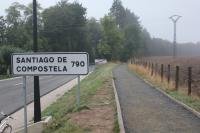
This site is emblematic of the question of what does it takes to tick off a site (does this one counts ?). It is a route (el camino) about 700 km long, from the French border in the Pyrenees mountains to the cathedral of Santiago de Compostella. The site boundaries includes the entire 700 km or so of camino and extend from 3 to 100 meters on both sides of the camino. It also includes about a few hundreds of associated monuments close to the camino.
Traditionnally, the pilgrimage needs to be done by foot, bicycle or on horse. To be validated, the pilgrims need only to cover the last 100 km, or 200 km on bicycle, and then recieve the compostela (the pilgrimage certificate).
Most people walking or cycling the camino nowadays are not religious. They do it for meditation, adventure or just for fun vacations.
I decided that I needed to complete the 700 km in order to tick off the site. Lacking time, I decided to cycle the route. I rented a bicycle in Roncevalles (the first village after the French border) and cycled all the way to Santiago. It took me 11 days, during which I almost didn't leave the boundaries of the site.
The camino is well indicted with yellow arrows or scallop painted on walls, stones or trees. A detailed map is therefore not necessary. It follows all kind of differents tracks, dirt roads or concrete roads, but all efforts are made to avoid …
Keep reading 0 comments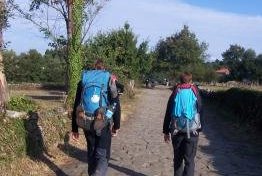
It was about 5km outside of Sarria that I spoke to my first proper Pilgrim, or Perigrino as they are locally known. I was feeling pretty good having decided to walk the last 120km of the Pilgrimage Route to qualify for my Compestela and properly ‘tick off’ this world heritage site.
The South Korean Pergirno asked me “Where did you start walking from?”
“Sarria, I only just started, but I feel good an hour into the pilgrimage. How about you, where did you start?”
“Paris”
“Paris!”
“Yes, I started 3 months ago at Notre Dame”
We walked on talking, we passed a few full pilgrim hostels before eventually finding one with space. We ended up having to share a double mattress on the floor in a room crammed with 30 other perigrinos. Later settling down to a rather limp looking steak, I talked about how there was no hot water in the single shower for all 30+ of us.
A German on the next table turned to me
“Welcome to the Camino!”
And this was how life progressed for the next 3 days. Endlessly meeting and talking to a huge array of people; each with their own reasons for doing the Pilgrimage; some wanted a break from everyday stresses to sort out their direction in life; some for religious reasons and many just wanted to walk for the experience. I met and spoke to people from all over the world, but liberal European holiday allowances and the location meant that …
Keep reading 0 comments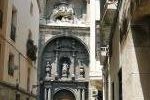
During my visits to the Route of Santiago I saw many groups of pilgrims walking and cycling towards Santiago de Compostela. I also met up with them at overnight stops where I noticed that restaurants were open to pilgrims at all hours, not just at traditional Spanish meal times. I did not walk the Route myself, but visited a number of the sites that were accessible by bus and train, such as:
Jaca, the cathedral, ayuntemento, citadel and St Michael's Bridge.
Puenta La Reina (Aragon), bridge
Najera, the Monastery of Sta Maria la Reale
Logrono, church of St James
Puenta La Reina (Navarra),the Roman bridge and the churches of St James and the Crucifixion
Estella, the church of San Pedro de la Rua
Santo Domingo de la Calzada, cathedral and hermitage
Fromista, the recently restored St Martin's church,
Astorga, the cathedral (closed) and Gaudi's episcopal palace
Leon, the cathedral and San Isidoro's church
Ponferrada, the Templar castle
Keep reading 0 comments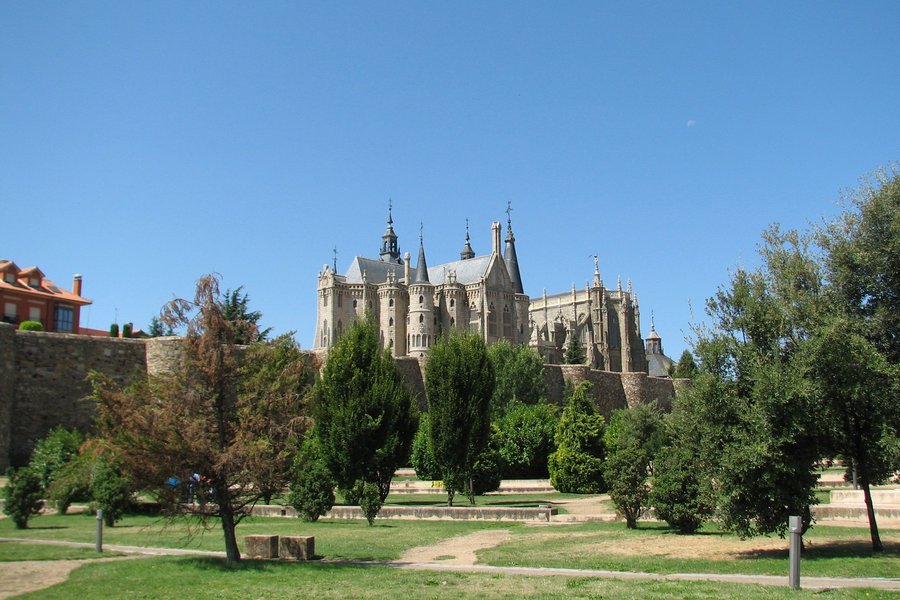
One should only be allowed to tick this WHS if you’ve walked enough of the pilgrimage route to earn your Compostela certificate! That is: having walked or ridden horseback at least the last 100km or cycled the last 200km. For my part, I have to admit that I haven’t reached Santiago de Compostela. Even not by car. After having visited Las Médulas in the morning, I decided that it would be too far to drive on to Santiago. So I went to Astorga instead, one of the major stops on the Route.
Astorga has two very fine works of architecture: the Episcopal Palace, designed by Gaudí, and the Gothic Cathedral. Both are named specifically in the AB evaluation, so I guess it’s kosher to visit these buildings as representations of the works of faith and art that make up this WHS.
The Gaudí Palace looks like a church and now has a museum inside. The exhibition didn’t really do anything for me, but it’s also a fine way to admire the architecture of the building from the inside. It was inspired by the rooms full of arches in the Mezquita of Cordoba. It has the same red/white striped pillars and stained glass windows.
I didn’t get into the Cathedral (closed), but its façade is very much worth checking out. It is extremely flashy!
I did not encounter many ‘pilgrims’ in Astorga or on the road, certainly not on foot. I do wonder, however, what it is like to walk this …
Keep reading 0 comments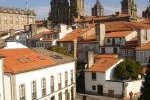
My Spanish friend told me that “walking on the Camino de Compostela in whatever length is always special and good for you!”. From his words I decided to make a pilgrimage to Santiago de Compostela, but I did not want to walk from Spanish border to Santiago de Compostela in Galicia which will consume a lot of time and faith that I did not have much. As my friend said “in whatever length is always special!”, I chose to walk from Monte do Gozo (Mount of Joy) to Santiago de Compostela which is the last section of the Camino and maybe the most important part for many pilgrims.
Monte do Gozo is the hill outside Santiago de Compostela providing a first view of the city with the spires of the cathedral, the end of the route. Reportedly that many pilgrims cried with joy when they reach this place, but as my visit was in winter there were no pilgrims at all just a hill with a big sculpture that built to commemorate the visit of the Pope to this holy town. Also I could not see the spires of the cathedral as most people claimed! From the hill, I had walked back to the town until I reached the square with the great cathedral. The cathedral is very beautiful and deservedly to be the end of the route. The interiors are very rich with details, and the golden altar of Saint John is just amazing and I believe these will …
Keep reading 0 comments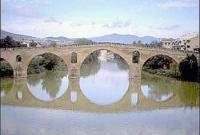
Why on Earth is this inscribed as a separate site from Santiago de Compostela itself? So little of visual consequence was the UNESCO Web site apparently able to find along the route that it even uses a picture of the Cathedral at Santiago to introduce it! And then, of course, France has inscribed its part of the pilgrimage route separately (see my review) – making a total of 3 “Compostela” inscriptions in all.
I would not argue against inscribing the pilgrimage route. So significant was the journey and so long did it take that it is studded by buildings created to support the pilgrimage but by splitting the objective from the journey (and by splitting even that into 2) UNESCO and Spain/France have, in my view, belittled the totality. And for what – political reasons no doubt? Yet the entire route in both France and Spain has been designated as the first “European Cultural Itinerary” so cooperation was achieved in that case – why not in UNESCO? Spain’s policy regarding WHS nominations has always been to “share out” its sites across its Autonomous Regions and the Compostela Route gives 5 of them a “share”. (Interestingly the 3 regions making up the Basque autonomous community of Euskadi are alone, as of end 2005, in having no inscribed site - it is said that the Basques have not, for political reasons, participated in the Spanish nominating council). The French Compostela route lists 69 selected buildings out of a possible 800 but the …
Keep reading 0 comments
